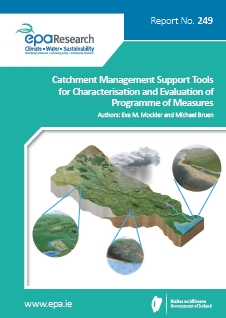Authors: Eva M. Mockler and Michael Bruen
Summary: Nutrient enrichment and eutrophication can negatively impact on freshwater ecosystems, estuarine and coastal waters. As a result of improvements in nutrient management and regulation, there has been a large reduction in total phosphorus, total ammonia and total nitrogen emissions from Irish catchments in recent decades.

Nutrient enrichment and eutrophication can negatively impact freshwater ecosystems and estuarine and coastal waters. A load apportionment modelling framework was developed to characterise sources of phosphorus and nitrogen emissions to water at a range of spatial scales from sub-catchment to national. The resulting Source Load Apportionment Model (SLAM) quantifies nutrient losses from both point discharges (urban wastewater, industry and septic tank systems) and diffuse sources (pasture, arable, forestry, peatlands, etc.).
Agriculture is the main source of nitrogen emissions to water across all regions of Ireland. The main sources of phosphorus are from wastewater and agriculture, with wide variations across the country related to local anthropogenic pressures (i.e. arising from human activity) and the hydrogeological setting. By synthesising large amounts of information, the SLAM framework predicted the dominant sources of nutrients at regional and local scales, contributing to the national nutrient risk assessment of Irish water bodies.
Results from this project informed the assessment of the 583 sub-catchments in Ireland within the national Water Framework Directive (WFD) characterisation process. These assessments were carried out by the EPA, with assistance from local authorities, Inland Fisheries, and other public bodies, to determine the significant pressures impacting water bodies that are at risk of not meeting their WFD objectives. A significant pressure is one that is impacting Ireland’s water quality in a particular water body, and which needs to be addressed before the water quality will improve.
Determining which pressures are significant is important so that measures can be specifically targeted to achieve water quality improvements. The source apportionment results were interpreted by catchment scientists, along with the other national datasets including ecological status and trends in ecological and chemical monitoring data; information on land use, pressures, pathways and the sensitivity of receptors; licence, enforcement, audit and inspection information from regulatory agencies; and local, on-the-ground knowledge from the local authorities and fisheries agency staff.
The data analysis tools and models developed for assessing nutrients in Irish catchments were used by catchment scientists to support the characterisation of nutrient sources, pathways and receptors in catchments. These tools will continue to be used to assess potential mitigation measures in that they provide capabilities for scenario analyses to support integrated catchment management in Ireland, including;
local-scale scenario analyses to identify potential nutrient reduction options to achieve Good status in nutrient-impacted water bodies; and
regional-scale scenario analyses to assess the impact of future projections of land cover and land use change, population increases and wastewater treatment improvements.